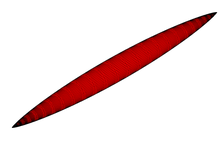Transonic
This article includes a list of references, related reading, or external links, but its sources remain unclear because it lacks inline citations. (November 2010) |
This article relies largely or entirely on a single source. (November 2010) |





In aeronautics, transonic speed refers to the condition of flight in which a range of velocities of airflow exist surrounding and flowing past an air vehicle or an airfoil that are concurrently below, at, and above the speed of sound in the range of Mach 0.8 to 1.2, i.e. 600–900 mph. This condition depends not only on the travel speed of the craft, but also on the pressure and temperature of the airflow of the vehicle's local environment. It is formally defined as the range of speeds between the critical Mach number, when some parts of the airflow over an air vehicle or airfoil are supersonic, and a higher speed, typically near Mach 1.2, when all of the airflow is supersonic. Between these speeds some of the airflow is supersonic, and some is not.
Most modern jet powered aircraft are engineered to operate at transonic air speeds. Transonic airspeeds see a rapid increase of drag from about Mach 0.8, and it is the fuel costs of the drag that typically limits the airspeed. Attempts to reduce wave drag can be seen on all high-speed aircraft; most notable is the use of swept wings, but another common form is a wasp-waist fuselage as a side effect of the Whitcomb area rule.
Severe instability can occur at transonic speeds. Shock waves move through the air at the speed of sound. When an object such as an aircraft also moves at the speed of sound, these shock waves build up in front of it to form a single, very large shock wave. During transonic flight, the plane must pass through this large shock wave, as well as contending with the instability caused by air moving faster than sound over parts of the wing and slower in other parts.
Transonic speeds can also occur at the tips of rotor blades of helicopters and aircraft. However, as this puts severe, unequal stresses on the rotor blade, it is avoided and may lead to dangerous accidents if it occurs. It is one of the limiting factors to the size of rotors, and also to the forward speeds of helicopters (as this speed is added to the forward-sweeping (leading) side of the rotor, thus possibly causing localized transonics).
Condensation clouds
At transonic speeds intense low-pressure areas form at various points around an aircraft. If conditions are right (i.e. high humidity) visible clouds will form in these low-pressure areas as shown in the illustration; these are called Prandtl-Glauert singularities. These clouds remain with the aircraft as it travels. It is not necessary for the aircraft as a whole to reach supersonic speeds for these clouds to form.
Transonic flows in astronomy and astrophysics
In astrophysics, wherever there is evidence of shocks (standing, propagating or oscillating), the flow close by must be transonic, as only supersonic flows form shocks. Interestingly, all black hole accretions are transonic (S.K. Chakrabarti, ApJ, 1996, v. 471, p. 237). Many such flows also have shocks very close to the black holes.
The outflows or jets from young stellar objects or disks around black holes can also be transonic since they start subsonically and at a far distance they are invariably supersonic. Supernovae explosions are accompanied by supersonic flows and shock waves. Bow shocks formed in solar winds around the earth are a direct result of transonic winds from the sun.
See also
- Anti-shock body
- Subsonic flows
- Supersonic flows
- Hypersonic flows
References
- Theory of Transonic Astrophysical Flows. Sandip K. Chakrabarti, World Scientific Publishers, Singapore (1990)
